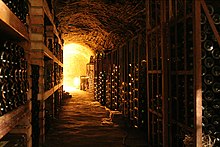Wine cellar

Awine cellaris astorage roomforwineinbottlesorbarrels,or more rarely incarboys,amphorae,orplastic containers.In anactivewine cellar, important factors such as temperature and humidity are maintained by a climate control system. In contrast,passivewine cellars are not climate-controlled, and are usually built underground to reduce temperature swings. An aboveground wine cellar is often called awine room,while a small wine cellar (fewer than 500 bottles) is sometimes termed awine closet.The household department responsible for the storage, care and service of wine in a great mediaeval house was termed thebuttery.Large wine cellars date back over 3,700 years.[1]
Purpose
[edit]Wine cellars protectalcoholic beveragesfrom potentially harmful external influences, providingdarkness,constanttemperature,and constanthumidity.Wine is a natural, perishable food product issued from fermentation of fruit. Left exposed to heat, light, vibration or fluctuations in temperature andhumidity,all types of wine can spoil. When properly stored, wines not only maintain their quality but many actually improve in aroma, flavor, and complexity as they mature. Depending on their level of sugar and alcohol, wines are more or less sensitive to temperature variances; wine with higher alcohol and/or sugar content will be less sensitive to temperature variance.[citation needed]
Conditions
[edit]Wine can be stored satisfactorily between 7–18 °C (45–64 °F) as long as any variations are gradual. A temperature of 13 °C (55 °F), much like that found in thecavesused to store wine in France, is ideal for both short-term storage and long-term aging of wine. Wine generally matures differently and more slowly at a lower temperature than it does at a higher temperature.[2]When the temperature swings are significant, 14 degrees or more, it will cause the wine to breathe through the cork which significantly speeds up the aging process. Between 10–14 °C (50–57 °F), wines will age normally.[3]
Active versus passive
[edit]Wine cellars can be either active or passively cooled. Active wine cellars are highlyinsulatedand need to be properly constructed. They require specialized wine cellarconditioningand cooling systems to maintain the desired temperature and humidity. In a very dry climate, it may be necessary to actively humidify the air, but in most areas this is not necessary. Passive wine cellars must be located in naturally cool and damp areas with minor seasonal and diurnal temperature variations, for example, a basement in a temperate climate. Passive cellars may be less predictable, but cost nothing to operate and are not affected bypower outages.[citation needed]
Humidity
[edit]Some wine experts debate the importance of humidity for proper wine storage. In theWine Spectator,writerMatt Kramernoted aFrenchstudy which claimed that therelative humiditywithin a bottle is maintained 100% regardless of theclosureused or the orientation of the bottle.[4]However,Alexis Lichinesays that low humidity can be a problem because it may cause organic corks to dry prematurely. One inch (2.5 cm) of gravel covering the floor periodically sprinkled with a little water was recommended to retain the desired humidity.[3]
Gallery
[edit]-
A table for drinking and gathering in aSonomawine cellar
-
Wine bottles stored in a wine cellar atJesus College, Oxford
-
Muga Wine cellar, Haro, Spain
-
Mileștii Micihas the world's biggest wine cellars.
-
Wine cellar ofSchramsberg Vineyards,Napa
-
Asherrysolera over the ground
-
An above ground wine cellar inRuncu - Romania
-
The formernymphaeumat theHôtel de Besenvalafter its transformation into a wine cellar in 2024
See also
[edit]- Storage of wine
- Aging of wine
- CellarTracker(database)
References
[edit]- ^Wilford, John Noble (22 November 2013)."Wine Cellar, Well Aged, Is Revealed in Israel".The New York Times.Retrieved26 November2013.
- ^Walder, Gene."The Science of Aging Wine".Vintage Cellars.Retrieved28 November2011.
- ^abLichine, Alexis (1967).Alexis Lichine's Encyclopedia of Wines and Spirits.London: Cassell & Company Ltd. Ch. 6, pp. 22–24.
- ^Kramer, Matt (October 31, 2007)."Seeking Closure".The Wine Spectator.p. 36.









